Assessing the Impacts of Climate Change on Hydrological Processes in a German Low Mountain Range Basin: Modelling Future Water Availability, Low Flows and Water Temperatures Using SWAT+
Abstract
1. Introduction
- How will projected climate change alter the seasonal dynamics and long-term trends of discharge and low flow events in the low mountain range catchment through 2100?
- How will rising air temperatures influence water temperatures, affecting thermal stress in aquatic ecosystems?
- What spatial differences in hydrological responses exist at the subcatchment level, and how can they be linked to catchment characteristics to identify vulnerable and resilient subcatchments?
2. Methods and Methodology
2.1. Study Area
2.2. Model Setup
2.2.1. Data Sources and Model Inputs
2.2.2. Model Adjustments
2.2.3. Sensitivity Analysis
2.2.4. Calibration and Validation
2.2.5. Climate Projections and Scenario Selection
2.3. Methods of Data Analysis
2.3.1. Temporal Analysis of Discharge and Water Temperature
2.3.2. Low Flow Analysis
2.3.3. Spatial Analysis of Discharge, Water Yield and Water Temperature
- SURQ = surface runoff;
- LATQ = lateral flow;
- GWQ = baseflow;
- TLOSS = transmission losses.
3. Results
3.1. Temporal Analysis of Discharge and Water Temperature
3.2. Low Flow Analysis
3.3. Spatial Analysis of Discharge, Water Yield and Water Temperature
4. Discussion
4.1. Discharge and Low Flow
4.2. Water Temperature
4.3. Spatial Analysis
4.3.1. Southern Subcatchments
4.3.2. Northern Subcatchments
4.4. Uncertainties and Limitations
5. Summary and Conclusions
Author Contributions
Funding
Data Availability Statement
Acknowledgments
Conflicts of Interest
References
- Abbas, M.; Zhao, L.; Wang, Y. Perspective Impact on Water Environment and Hydrological Regime Owing to Climate Change: A Review. Hydrology 2022, 9, 203. [Google Scholar] [CrossRef]
- Cao, Z.; Wang, S.; Luo, P.; Xie, D.; Zhu, W. Watershed Ecohydrological Processes in a Changing Environment: Opportunities and Challenges. Water 2022, 14, 1502. [Google Scholar] [CrossRef]
- Chaturvedi, A.; Pandey, B.; Yadav, A.K.; Saroj, S. An Overview of the Potential Impacts of Global Climate Change on Water Resources. In Water Conservation in the Era of Global Climate Change; Elsevier: Amsterdam, The Netherlands, 2021; pp. 99–120. ISBN 978-0-12-820200-5. [Google Scholar]
- Sohoulande Djebou, D.C.; Singh, V.P. Impact of Climate Change on the Hydrologic Cycle and Implications for Society. Environ. Soc. Psychol. 2016, 1, 36–49. [Google Scholar] [CrossRef]
- Schneider, C.; Laizé, C.L.R.; Acreman, M.C.; Flörke, M. How Will Climate Change Modify River Flow Regimes in Europe? Hydrol. Earth Syst. Sci. 2013, 17, 325–339. [Google Scholar] [CrossRef]
- Christensen, J.H.; Hewitson, B.; Busuioc, A.; Chen, A.; Gao, X.; Held, I.; Jones, R.; Kolli, R.; Kwon, W.; Laprise, R.; et al. Regional Climate Projections. In Climate Change 2007: The Physical Science Basis. Contribution of Working Group I to the Fourth Assessment Report of the Intergovernmental Panel on Climate Change; 2007; Available online: https://www.ipcc.ch/report/ar4/wg1/ (accessed on 4 March 2025).
- Alcamo, J.; Flörke, M.; Märker, M. Future Long-Term Changes in Global Water Resources Driven by Socio-Economic and Climatic Changes. Hydrol. Sci. J. 2007, 52, 247–275. [Google Scholar] [CrossRef]
- Riedel, T.; Nolte, C.; aus der Beek, T.; Liedtke, J.; Sures, B.; Grabner, D. Niedrigwasser, Dürre und Grundwasserneubildung—Bestandsaufnahme zur gegenwärtigen Situation in Deutschland, den Klimaprojektionen und den existierenden Maßnahmen und Strategien; German Environment Agency: Dessau-Roßlau, Germany, 2021. [Google Scholar]
- BUND Auswirkungen des Klimawandels auf den Wasserhaushalt. Ein Hintergrunddossier zu den Auswirkungen des Klimawandels auf den Zustand und die Gefährdung der Gewässer in Deutschland und die Folgen für die Nutzungen. BUND-Gewässerpapier 2020. Available online: https://digital.zlb.de/viewer/metadata/34758580/1/ (accessed on 4 March 2025).
- Brienen, S.; Walter, A.; Brendel, C.; Fleischer, C.; Ganske, A.; Haller, M.; Helms, M.; Höpp, S.; Jensen, C.; Jochumsen, K.; et al. Klimawandelbedingte Änderungen in Atmosphäre Und Hydrosphäre: Schlussbericht Des Schwerpunktthemas Szenarienbildung (SP-101) Im Themenfeld 1 Des BMVI-Expertennetzwerks. 2020, p. 157. Available online: https://www.bmdv-expertennetzwerk.bund.de/DE/Publikationen/TFSPTBerichte/SPT101.html (accessed on 4 March 2025).
- Flörke, M.; Uschan, T.; Stein, U.; Tröltzsch, J.; Vidaurre, R.; Schritt, H.; Bueb, B.; Reineke, J.; Herrmann, F.; Kollet, S.; et al. Auswirkung des Klimawandels auf die Wasserverfügbarkeit. Anpassung an Trockenheit und Dürre in Deutschland (WAD-Klim). 2024. Available online: https://www.umweltbundesamt.de/publikationen/auswirkung-des-klimawandels-auf-die (accessed on 4 March 2025).
- German Environment Agency. Interministerial Working Group on Adaptation to Climate Change 2023 Monitoring Report on the German Strategy for Adaptation to Climate Change; German Environment Agency: Dessau-Roßlau, Germany, 2023. [Google Scholar]
- David, A.; Schmalz, B. Flood Hazard Analysis in Small Catchments: Comparison of Hydrological and Hydrodynamic Approaches by the Use of Direct Rainfall. J. Flood Risk Manag. 2020, 13, e12639. [Google Scholar] [CrossRef]
- David, A.; Schmalz, B. A Systematic Analysis of the Interaction Between Rain-on-Grid-Simulations and Spatial Resolution in 2D Hydrodynamic Modeling. Water 2021, 13, 2346. [Google Scholar] [CrossRef]
- David, A.; Rodriguez, E.R.; Schmalz, B. Importance of Catchment Hydrological Processes and Calibration of Hydrological-hydrodynamic Rainfall-runoff Models in Small Rural Catchments. J. Flood Risk Manag. 2023, 16, e12901. [Google Scholar] [CrossRef]
- Grosser, P.F.; Schmalz, B. Low Flow and Drought in a German Low Mountain Range Basin. Water 2021, 13, 316. [Google Scholar] [CrossRef]
- Grosser, P.F.; Schmalz, B. Projecting Hydroclimatic Extremes: Climate Change Impacts on Drought in a German Low Mountain Range Catchment. Atmosphere 2023, 14, 1203. [Google Scholar] [CrossRef]
- Grosser, P.F.; Xia, Z.; Alt, J.; Rüppel, U.; Schmalz, B. Virtual Field Trips in Hydrological Field Laboratories: The Potential of Virtual Reality for Conveying Hydrological Engineering Content. Educ. Inf. Technol. 2023, 28, 6977–7003. [Google Scholar] [CrossRef]
- Kissel, M.; Schmalz, B. Comparison of Baseflow Separation Methods in the German Low Mountain Range. Water 2020, 12, 1740. [Google Scholar] [CrossRef]
- Kissel, M.; Bach, M.; Schmalz, B. Evaluation of Baseflow Modeling with BlueM.Sim for Long-Term Hydrological Studies in the German Low Mountain Range of Hesse, Germany. Hydrology 2023, 10, 222. [Google Scholar] [CrossRef]
- Kissel, M.; Bach, M.; Schmalz, B. Impact of the Model Structure and Calibration Strategy on Baseflow Modeling in the German Low Mountain Range. J. Hydroinform. 2024, 26, 1692–1714. [Google Scholar] [CrossRef]
- Schmalz, B.; Kruse, M. Impact of Land Use on Stream Water Quality in the German Low Mountain Range Basin Gersprenz. Landsc. Online 2019, 72, 1–17. [Google Scholar] [CrossRef]
- Scholand, D.; Schmalz, B. Deriving the Main Cultivation Direction from Open Remote Sensing Data to Determine the Support Practice Measure Contouring. Land 2021, 10, 1279. [Google Scholar] [CrossRef]
- Scholand, D.; Schmalz, B. Automated Quantification of Contouring as Support Practice for Improved Soil Erosion Estimation Considering Ridges. Int. Soil Water Conserv. Res. 2024, 12, 761–774. [Google Scholar] [CrossRef]
- Bieger, K.; Arnold, J.G.; Rathjens, H.; White, M.J.; Bosch, D.D.; Allen, P.M.; Volk, M.; Srinivasan, R. Introduction to SWAT+, A Completely Restructured Version of the Soil and Water Assessment Tool. JAWRA J. Am. Water Resour. Assoc. 2017, 53, 115–130. [Google Scholar] [CrossRef]
- Riahi, K.; Rao, S.; Krey, V.; Cho, C.; Chirkov, V.; Fischer, G.; Kindermann, G.; Nakicenovic, N.; Rafaj, P. RCP 8.5—A Scenario of Comparatively High Greenhouse Gas Emissions. Clim. Change. 2011, 109, 33–57. [Google Scholar] [CrossRef]
- IPCC 5th Assessment Synthesis Report: Summary for Policymakers. Available online: http://ar5-syr.ipcc.ch/topic_summary.php (accessed on 4 March 2025).
- Ihwb Feldlabor. Available online: https://www.ihwb.tu-darmstadt.de/forschung_ihwb/feldlabor_ihwb/index.de.jsp (accessed on 25 April 2025).
- CDC Climate Data Center. Available online: https://www.dwd.de/EN/climate_environment/cdc/cdc_node_en.html (accessed on 3 March 2025).
- HVBG Geodaten Online—Downloadcenter. Available online: https://gds.hessen.de/INTERSHOP/web/WFS/HLBG-Geodaten-Site/de_DE/-/EUR/ViewDownloadcenter-Start (accessed on 3 March 2025).
- AdV (Arbeitsgemeinschaft der Vermessungsverwaltungen der Länder der Bundesrepublik Deutschland) Amtliches Topographisch-Kartographisches Informationssystem (ATKIS). Available online: https://www.adv-online.de/AdV-Produkte/Geotopographie/ATKIS/ (accessed on 4 March 2025).
- BKG Bundesamt Für Kartographie Und Geodäsie. Available online: https://gdz.bkg.bund.de/index.php/default/open-data/corine-land-cover-5-ha-stand-2018-clc5-2018.html (accessed on 3 March 2025).
- HLNUG INSPIRE ATOM Feed Client. Available online: https://www.geoportal.hessen.de/mapbender/plugins/mb_downloadFeedClient.php?url=https%3A%2F%2Fwww.geoportal.hessen.de%2Fmapbender%2F%2Fphp%2Fmod_inspireDownloadFeed.php%3Fid%3De4e7e5a4-d53a-91b4-b68f-4086986d483e%26type%3DSERVICE%26generateFrom%3Dmetadata (accessed on 3 March 2025).
- HLNUG: Hessisches Landesamt für Naturschutz, Umwelt und Geologie. Discharge Data of the Gauges Harreshausen (ID: 24762653) and Groß Bieberau 2 (ID: 24761005); HLNUG: Wiesbaden, Germany, 2019. [Google Scholar]
- Destatis Land-Und Forstwirtschaft, Fischerei. Wachstum Und Ernte–Feldfrüchte–Fachserie 3 Reihe 3.2. Destatis Land-Und Forstwirtschaft, Fischerei: 2022. Available online: https://www.destatis.de/DE/Themen/Branchen-Unternehmen/Landwirtschaft-Forstwirtschaft-Fischerei/_inhalt.html (accessed on 4 March 2025).
- Achilles, W.; Anter, J.; Belau, T.; Blankenburg, J. Faustzahlen für die Landwirtschaft; 15. Auflage.; Kuratorium für Technik und Bauwesen in der Landwirtschaft e.V. (KTBL): Darmstadt, Germany, 2018; ISBN 978-3-945088-59-3. [Google Scholar]
- Clementini, C.; Pomente, A.; Latini, D.; Kanamaru, H.; Vuolo, M.R.; Heureux, A.; Fujisawa, M.; Schiavon, G.; Del Frate, F. Long-Term Grass Biomass Estimation of Pastures from Satellite Data. Remote Sens. 2020, 12, 2160. [Google Scholar] [CrossRef]
- BMEL Dritte Bundeswaldinventur. Available online: https://www.bundeswaldinventur.de/ (accessed on 3 March 2025).
- Encyclopædia Britannica Understanding Biomass in Forests. Available online: https://www.britannica.com/video/152193/biomass-forests (accessed on 3 March 2025).
- HessenForst Hesse–A Forest State. Available online: https://www.hessen-forst.de/ueber-den-landesbetrieb-hessenforst/hessenforst-sustainable-forest-management-engl (accessed on 3 March 2025).
- Katzenmaier D, Fritsch U, Bronstert A. 2001. Quantifizierung des Einflusses von Landnutzung und dezentraler Versickerung auf die Hochwasserentstehung. In Hochwasserschutz heute–Nachhaltiges Management; Heiden, S., Erb, R., Sieker, F., Eds.; Erich Schmidt Verlag: Berlin, Germany, 2001; pp. 327–357. [Google Scholar]
- Forst Erklärt Unsere Bäume—Die Rotbuche (Fagus Sylvatica). 2020. Available online: https://forsterklaert.de/die-rotbuche (accessed on 4 March 2025).
- Fleck, S.; Ahrends, B.; Meesenburg, H. Trockenstressrisiko Im Harz. AFZ-DerWald. 2022. Available online: https://www.digitalmagazin.de/marken/afz-derwald/hauptheft/2022-15/waldokologie/021_trockenstressrisiko-im-harz (accessed on 4 March 2025).
- Deutsche Welle Natur Und Umwelt, Wiederauferstehung Einer Waldlandschaft. Available online: https://www.dw.com/de/wiederauferstehung-einer-waldlandschaft/a-37104507 (accessed on 3 March 2025).
- Morris, M.D. Factorial Sampling Plans for Preliminary Computational Experiments. Technometrics 1991, 33, 161–174. [Google Scholar] [CrossRef]
- Van Griensven, A.; Meixner, T.; Grunwald, S.; Bishop, T.; Diluzio, M.; Srinivasan, R. A Global Sensitivity Analysis Tool for the Parameters of Multi-Variable Catchment Models. J. Hydrol. 2006, 324, 10–23. [Google Scholar] [CrossRef]
- Schuerz, C. SWATplusR. 2022. Available online: https://scholar.google.com/scholar?q=Schuerz%2C%20C.%20(2022).%20Getting%20started%20with%20SWATplusR%20%E2%80%A2%20SWATplusR (accessed on 4 March 2025).
- Chawanda, C. SWAT+ Toolbox; 2022. Available online: http://openwater.network/assets/downloads/SWATPlusToolboxv0.5.0Installer.exe (accessed on 4 March 2025).
- Gupta, H.V.; Sorooshian, S.; Yapo, P.O. Status of Automatic Calibration for Hydrologic Models: Comparison with Multilevel Expert Calibration. J. Hydrol. Eng. 1999, 4, 135–143. [Google Scholar] [CrossRef]
- Moriasi, D.N.; Arnold, J.G.; Liew, M.W.V.; Bingner, R.L.; Harmel, R.D.; Veith, T.L. Model Evaluation Guidelines for Systematic Quantification of Accuracy in Watershed Simulations. Trans. ASABE 2007, 50, 885–900. [Google Scholar] [CrossRef]
- Knoben, W.J.M.; Freer, J.E.; Woods, R.A. Technical Note: Inherent Benchmark or Not? Comparing Nash–Sutcliffe and Kling–Gupta Efficiency Scores. Hydrol. Earth Syst. Sci. 2019, 23, 4323–4331. [Google Scholar] [CrossRef]
- Gupta, H.V.; Kling, H.; Yilmaz, K.K.; Martinez, G.F. Decomposition of the Mean Squared Error and NSE Performance Criteria: Implications for Improving Hydrological Modelling. J. Hydrol. 2009, 377, 80–91. [Google Scholar] [CrossRef]
- Krähenmann, S.; Walter, A.; Klippel, L.; Statistische Aufbereitung Von Klimaprojektionen: Downscaling Und Multivariate Bias-Adjustierung—Im Rahmen Des BMVI-Expertennetzwerkes Entwickelte Verfahren Zum Postprocessing Von Klimamodelldaten. Berichte Des Deutschen Wetterdienstes 254. Available online: https://refubium.fu-berlin.de/handle/fub188/33572 (accessed on 4 March 2025).
- Krähenmann, S.; Haller, M.; Walter, A. A New Combined Statistical Method for Bias Adjustment and Downscaling Making Use of Multi-Variate Bias Adjustment and PCA-Driven Rescaling. Meteorol. Z. 2021, 30, 391–411. [Google Scholar] [CrossRef]
- Dalelane, C.; Früh, B.; Steger, C.; Walter, A. A Pragmatic Approach to Build a Reduced Regional Climate Projection Ensemble for Germany Using the EURO-CORDEX 8.5 Ensemble. J. Appl. Meteorol. Clim. 2018, 57, 477–491. [Google Scholar] [CrossRef]
- DWD Deutscher Wetterdienst. Available online: https://www.dwd.de/ref-ensemble (accessed on 4 March 2025).
- Shukla, P.R.; Skea, J.; Slade, R.; Al Khourdajie, A.; van Diemen, R.; McCollum, D.; Pathak, M.; Some, S.; Vyas, P.; Fradera, R.; et al. (Eds.) Climate Change 2022: Impacts, Adaptation and Vulnerability. Contribution of Working Group III to the Sixth Assessment Report of the Intergovernmental Panel on Climate Change; 2022; ISBN 978-92-9169-160-9. Available online: https://www.ipcc.ch/report/ar6/wg2/ (accessed on 4 March 2025).
- Kreienkamp, F.; Huebener, H.; Linke, C.; Spekat, A. Good Practice for the Usage of Climate Model Simulation Results–a Discussion Paper. Environ. Syst. Res. 2012, 1, 9. [Google Scholar] [CrossRef]
- WMO Guide to Climatological Practices. In Technical Report, World Meteorological Organization, (WMO-No. 100), 3rd ed.; World Meteorological Organization: Geneva, Switzerland, 2010.
- Stefan, H.G.; Preud’homme, E.B. Stream Temperature Estimation from Air Temperature. JAWRA J. Am. Water Resour. Assoc. 1993, 29, 27–45. [Google Scholar] [CrossRef]
- Neitsch, S.L.; Arnold, J.G.; Kiniry, J.R.; Williams, J.R. Soil and Water Assessment Tool Theoretical Documentation Version 2009. 2011. Available online: https://oaktrust.library.tamu.edu/items/ee261b66-c392-40d9-8c03-e455f5a8347e (accessed on 4 March 2025).
- KLIWA 7. In KLIWA Symposium. Zu Wenig|Zu Viel—Wasserwirtschaft Zwischen Trockenheit Und Starkregen; 2023; Available online: https://zentrum-klimaanpassung.de/vernetzung-veranstaltungen/termine/zu-wenig-zu-viel-wasserwirtschaft-zwischen-trockenheit-und-starkregen (accessed on 4 March 2025).
- Brahmer, G.; Wrede, S. Auswirkungen Des Klimawandels Auf Die Abflussver Hältnisse an Hessischen Flüssen Auf Basis Hochaufgelöster Klima- Und Wasserhaushaltsmodelle; Hessisches Landesamt für Umwelt und Geologie: Wiesbaden, Germany, 2014. [Google Scholar]
- Hergesell, M.; Hübener, D.H.; Gründel, A.; Lockwald, N.M.; Zarda, C. Reihe: Klimawandel in Hessen. 2014. Available online: https://www.hlnug.de/fileadmin/dokumente/klima/klimawandel_wasser.pdf (accessed on 4 March 2025).
- DWD Wetter Und Klima–Deutscher Wetterdienst–Glossar–H–Heißer Tag. Available online: https://www.dwd.de/DE/service/lexikon/Functions/glossar.html?nn=103346&lv2=101094&lv3=101162 (accessed on 6 March 2025).
- White, J.C.; Khamis, K.; Dugdale, S.; Jackson, F.L.; Malcolm, I.A.; Krause, S.; Hannah, D.M. Drought Impacts on River Water Temperature: A Process-based Understanding from Temperate Climates. Hydrol. Process. 2023, 37, e14958. [Google Scholar] [CrossRef]
- Graf, R. A Multifaceted Analysis of the Relationship between Daily Temperature of River Water and Air. Acta Geophys. 2019, 67, 905–920. [Google Scholar] [CrossRef]
- KLIWA KLIWA-Kurzbericht. 2-Grad-Ziel Für Unsere Bäche–Wassertemperatur Und Beschattung. Available online: https://www.kliwa.de/_download/KLIWA_Kurzbericht_Wassertemperatur_und_Beschattung.pdf (accessed on 6 March 2025).
- Holsinger, L.; Keane, R.E.; Isaak, D.J.; Eby, L.; Young, M.K. Relative Effects of Climate Change and Wildfires on Stream Temperatures: A Simulation Modeling Approach in a Rocky Mountain Watershed. Clim. Chang. 2014, 124, 191–206. [Google Scholar] [CrossRef]
- Ducharne, A. Importance of Stream Temperature to Climate Change Impact on Water Quality. Hydrol. Earth Syst. Sci. 2008, 12, 797–810. [Google Scholar] [CrossRef]
- Peters, K.; Kiesel, J.; Oswald, I.; Guse, B.; Noa-Yarasca, E.; Arnold, J.; Osorio Leyton, J.; Bieger, K.; Fohrer, N. The Integration of Hydrological and Heat Exchange Processes Improves Stream Temperature Simulations in an Ecohydrological Model. Hydrol. Process. 2025, 39, e70059. [Google Scholar] [CrossRef]
- Larance, S.; Wang, J.; Delavar, M.A.; Fahs, M. Assessing Water Temperature and Dissolved Oxygen and Their Potential Effects on Aquatic Ecosystem Using a SARIMA Model. Environments 2025, 12, 25. [Google Scholar] [CrossRef]
- Itua, E.; Uwadiae, R.E.; Victor-Lan, O. Thermal Pollution and the Aggravating Effects of Climate Change: Impact of Thermal Stress on Aquatic Ecosystems. Asian J. Sci. Res. 2024, 17, 1–12. [Google Scholar] [CrossRef]
- Watercenter Water Temperature Effects on Fish and Aquatic Life. Available online: http://www.watercenter.org/physical-water-quality-parameters/water-temperature/water-temperature-effects-on-fish-and-aquatic-life/ (accessed on 6 March 2025).
- Becht, A.; Diehl, M.; Friedrich, R.; Fritsche, J.-G.; Hergesell, M.; Hoselmann, C. Hydrogeologie von Hessen–Odenwald und Sprendlinger Horst; Kämmerer, D., Prein, A., Senner, R., Eds.; Grundwasser in Hessen; Hessisches Landesamt für Naturschutz, Umwelt und Geologie: Wiesbaden, Germany, 2017; ISBN 978-3-89026-961-0. [Google Scholar]
- Bundesanstalt für Gewässerkunde Hydrologischer Atlas Deutschland. Available online: https://geoportal.bafg.de/mapapps/resources/apps/HAD/index.html?lang=de&vm=2D&s=3000000&r=0&c=563594.9039036152%2C5676998.40659268 (accessed on 3 March 2025).
- Schraft, A.; Fritsche, J.-G.; Hemfler, M.; Mittelbach, G.; Tangermann, H. Die hydrogeologischen Einheiten Nordhessens, ihre Grundwasserneubildung und ihr nutzbares Grundwasserdargebot (Ldkrs. Waldeck-Frankenberg, Kassel, Schwalm-Eder, Werra- Meißner, Hersfeld-Rotenburg, Fulda und Stadt Kassel). Geol. Jb. Hess. 2002, 457, 27–53. [Google Scholar]
- Matthieu Goar Climate: Greenhouse Gas Emissions Are Too High, Pushing Planet Toward +3.1 °C Warming. Available online: https://www.lemonde.fr/en/environment/article/2024/10/24/climate-greenhouse-gas-emissions-are-too-high-pushing-planet-toward-3-1-c-warming_6730363_114.html (accessed on 3 March 2025).
- Nied, M.D. (LUBW) Einordnung der Ergebnisse des KLIWA-Ensembles in die aktuelle klimatische Entwicklung, Positionspapier zur Verwendung in der Wasserwirtschaft” (Report), Publisher: KLIWA. 2023. Available online: https://www.kliwa.de/_download/KLIWA-Positionspapier-2023_Einordnung_Klimaprojektionen_aktuelle_Entwicklung.pdf (accessed on 4 March 2025).




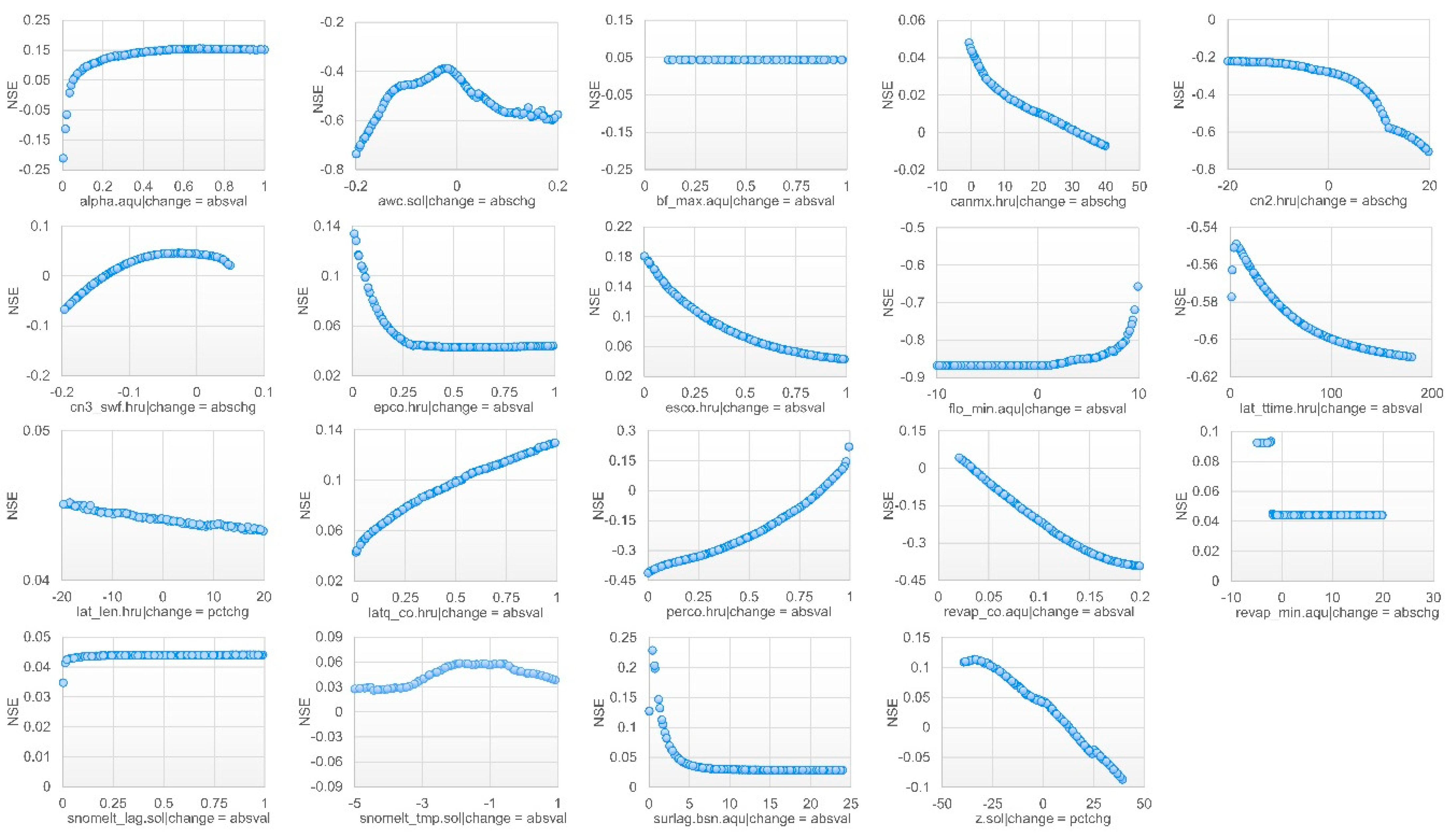



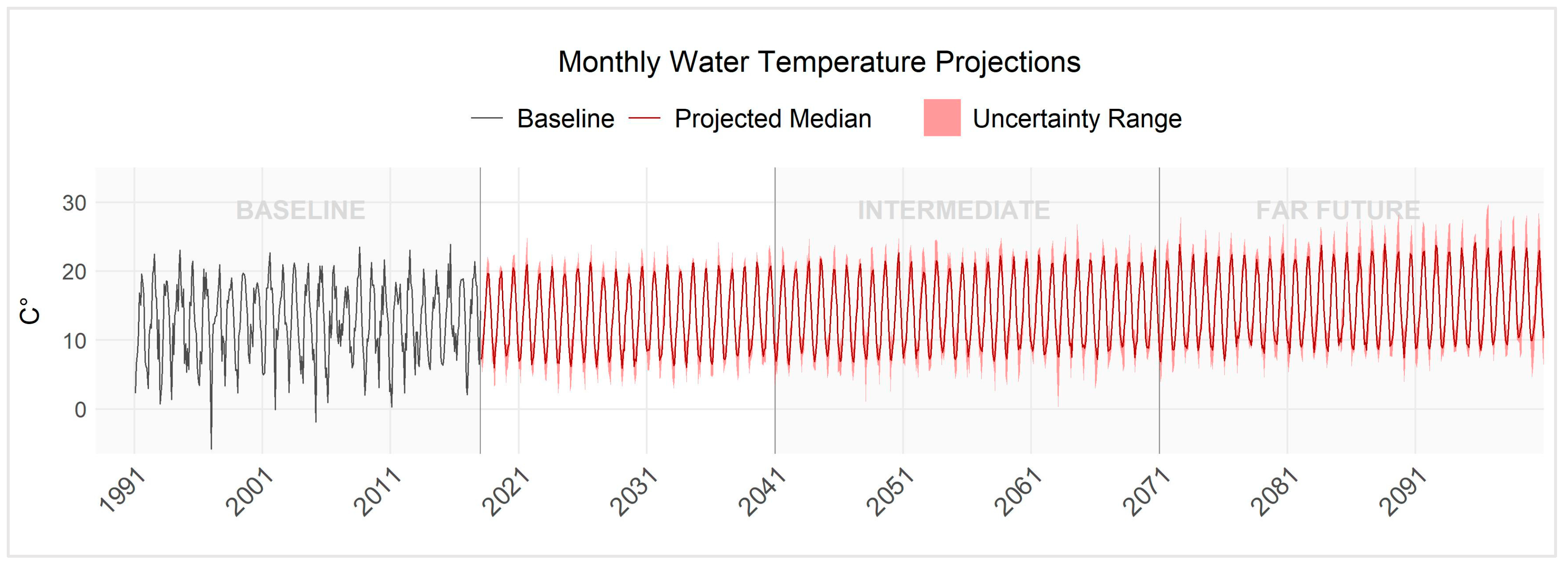
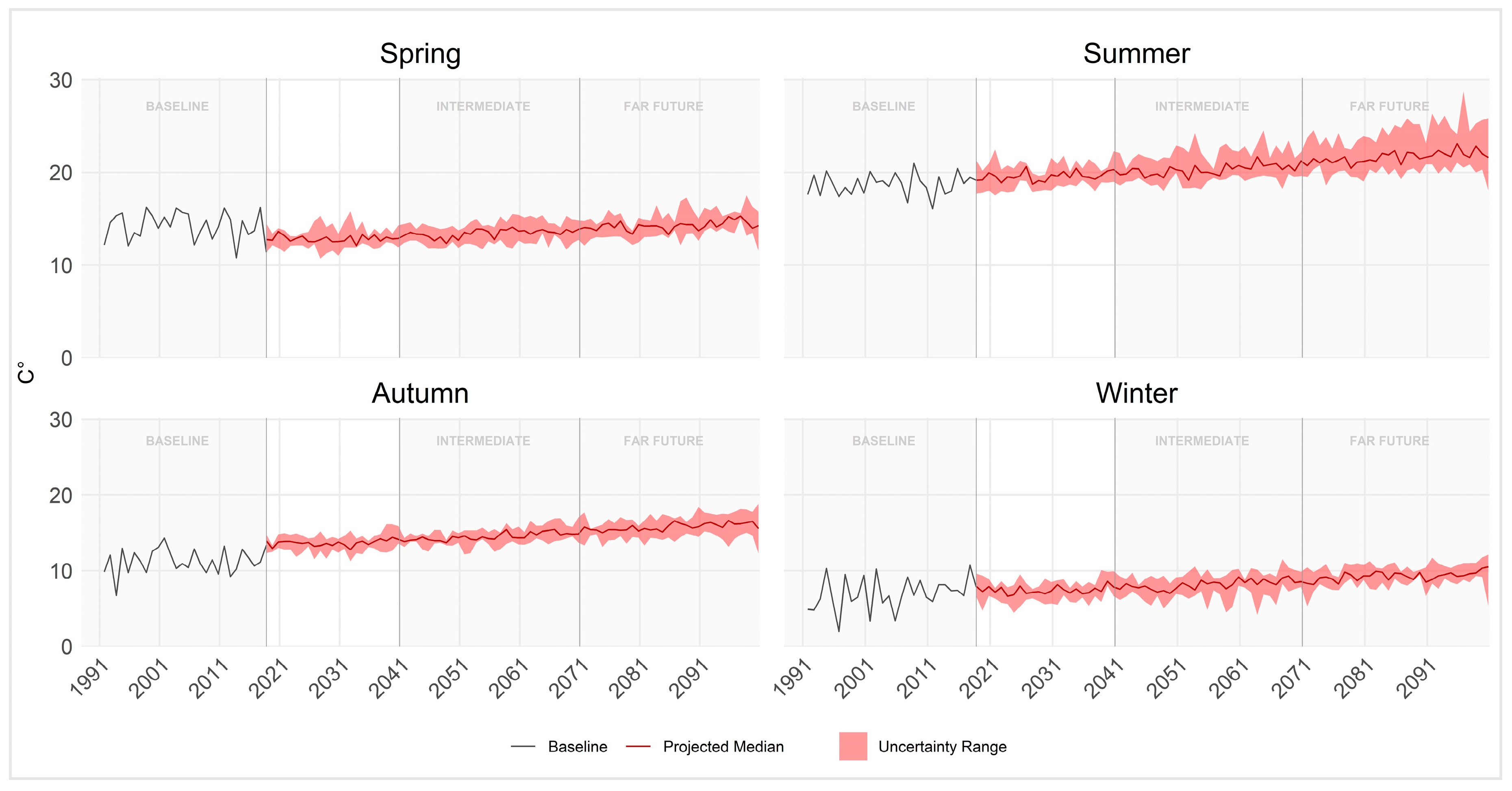

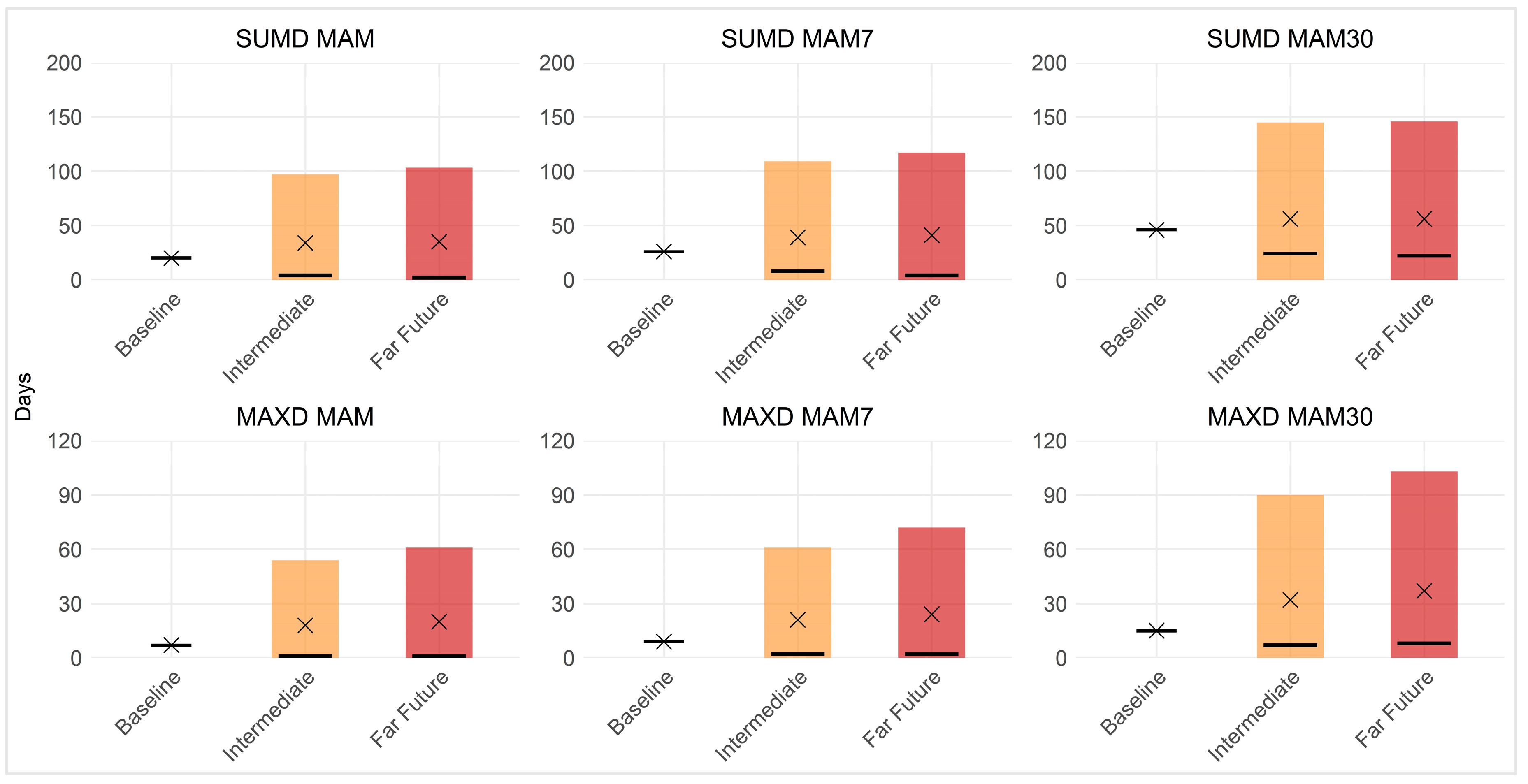
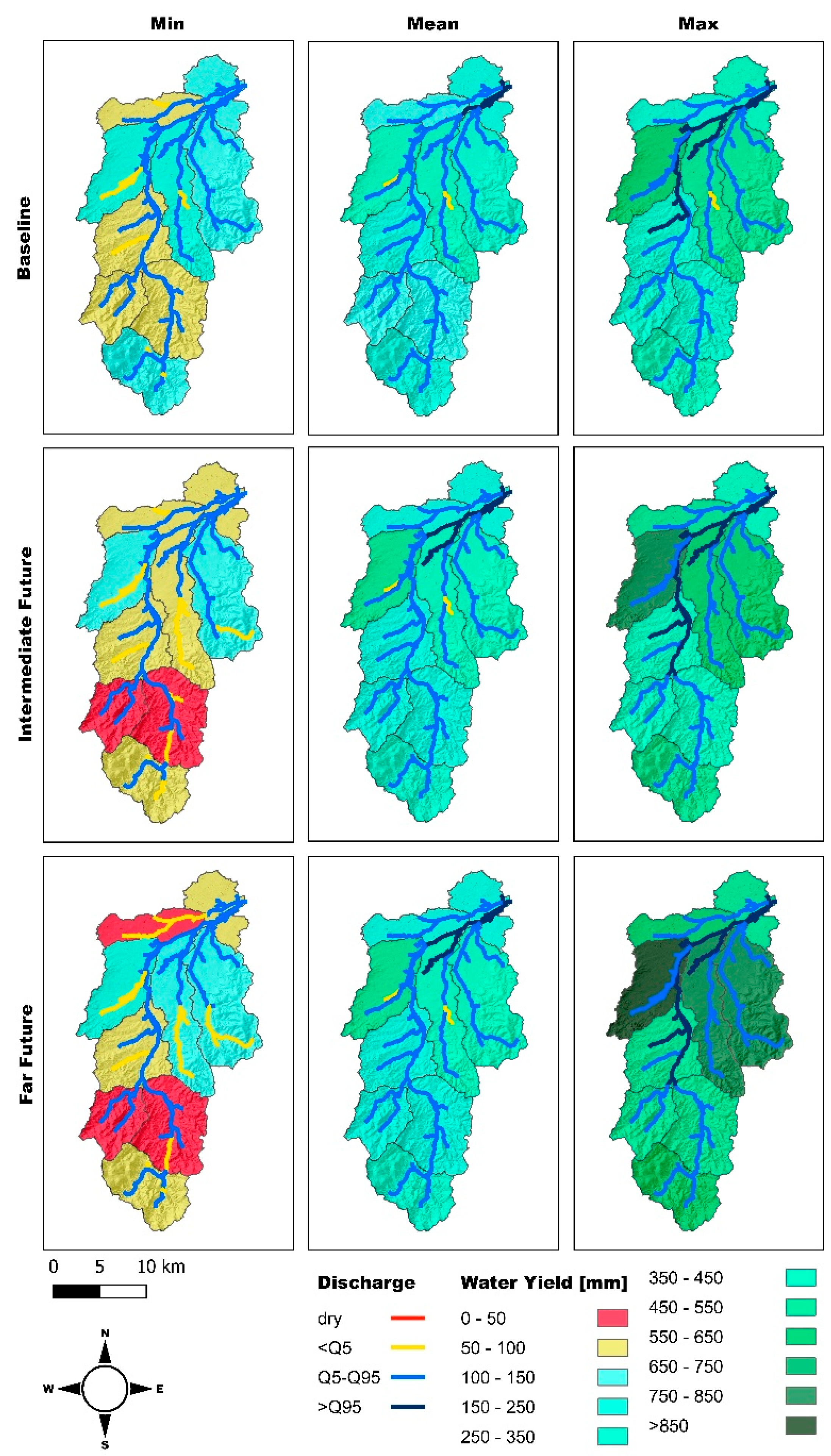
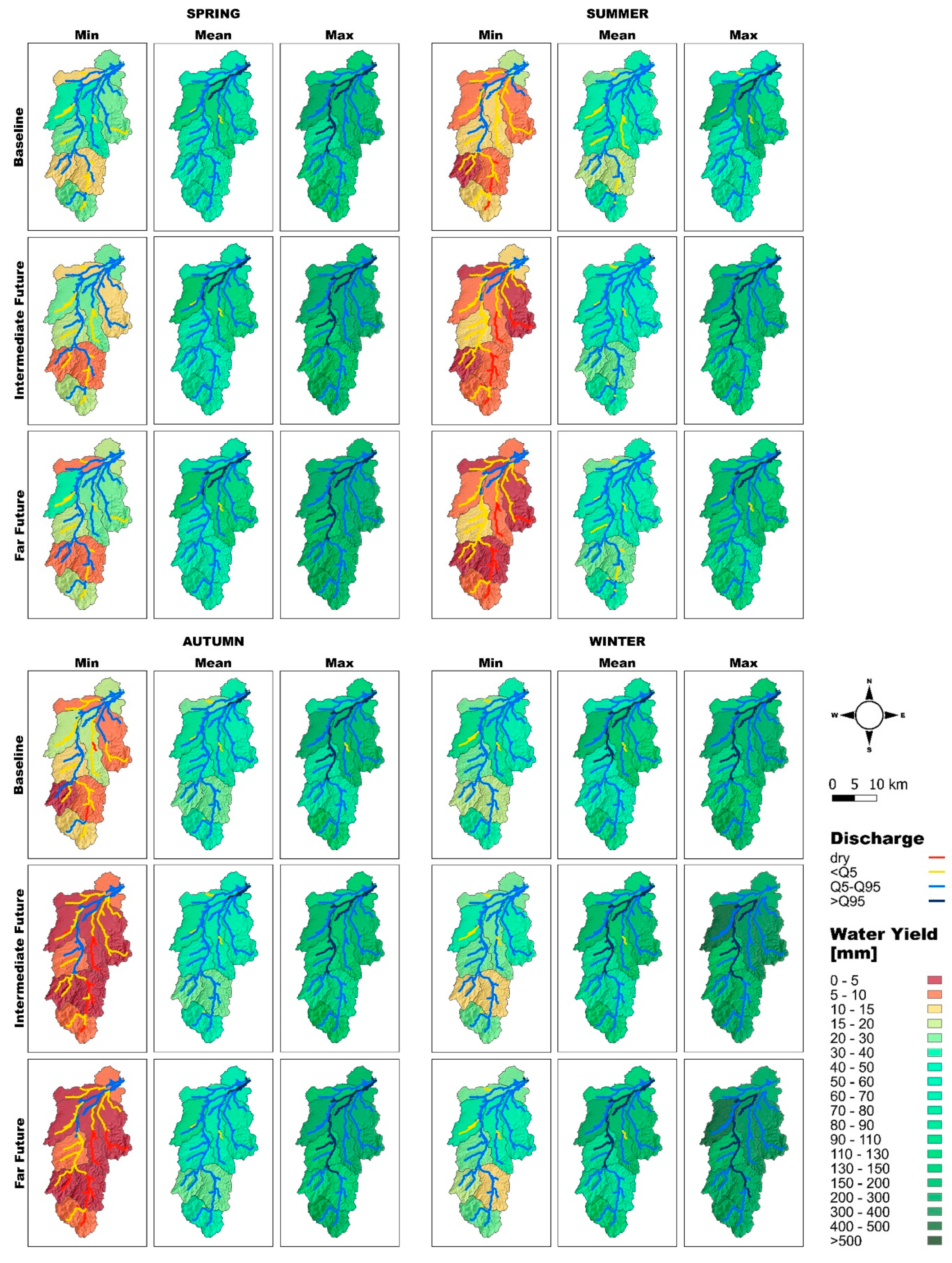

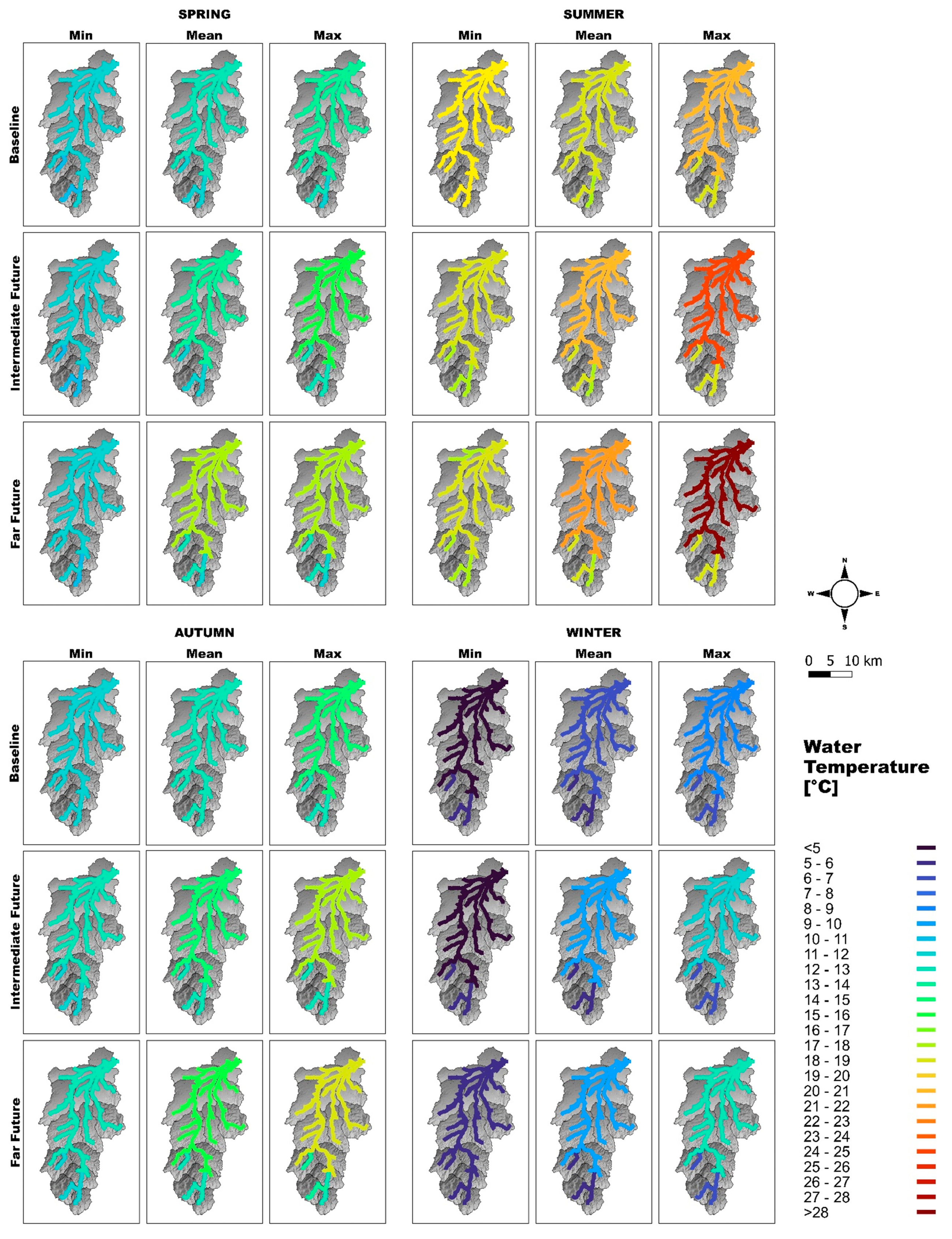
| Modelling Period | 01.01.1988 – 31.12.2017 | 30 Years |
|---|---|---|
| Warm-up | 1988–1990 | 3 years |
| Calibration | 1991–2008 | 18 years |
| Validation | 2009–2017 | 9 years |
| Application | Resolution | Source | |
|---|---|---|---|
| Digital Elevation Model (DEM) | Watershed Delineation | 5 m | Hessian Administration for Land Management and Geoinformation [30] |
| Stream Network | - | Official Topographic–Cartographic Information System [31] | |
| Land Cover | Hydrologic Response Units | 5 ha | CLC5_2018 [32] |
| Soil | 1:50,000 | Soil surface data Hesse [33] | |
| Observed Discharge | Calibration and Validation | Daily | Discharge data of the Gauge Harreshausen [34] |
| Observed Climate Data | Daily | German Weather Service [29] |
| Station | ID | Latitude | Longitude | Elevation 1 | Climate Parameters |
|---|---|---|---|---|---|
| Lautertal/ Odenwald-Reichenbach | 2900 | 49.7090 | 8.6908 | 208 | Precipitation |
| Michelstadt | 3284 | 49.6691 | 9.0085 | 240 | Precipitation, rel. humidity, temperature |
| Michelstadt-Vielbrunn | 3287 | 49.7176 | 9.0997 | 453 | Precipitation, temperature, wind speed |
| Roedermark/ Ober-Roden | 4230 | 49.9832 | 8.8395 | 137 | Precipitation |
| Schaafheim-Schlierbach | 4411 | 49.9195 | 8.9671 | 155 | Precipitation, temperature |
| Wuerzburg | 5705 | 49.7703 | 9.9577 | 268 | Global radiation |
| Dieburg | 955 | 49.8975 | 8.8486 | 145 | Precipitation |
| FRSD | FRST | FRSE | |
|---|---|---|---|
| bm_max [t/ha] (Maximum Biomass) | 275 | 250 | 200 |
| Years to Maturity | 100 | 95 | 80 |
| Maximum Canopy Height [m] | 30 | 50 | 50 |
| Maximum Root Depth [m] | 1.6 | 2 | 1.2 |
| Optimal Temperature for growth [°C] | 20 | 17 | 13 |
| Minimum T [°C] | 0 | 0 | 0 |
| Bio_e (Biomass Energy Ratio) | 20 | 20 | 15 |
| Parameter | Description | Change | Value |
|---|---|---|---|
| alpha.aqu | Baseflow alpha factor (days)—controls recession of groundwater flow. | absval | 0.68 |
| awc.sol | Available water capacity of the soil layer (mm H2O/mm soil)—affects soil moisture storage. | abschg | −0.15 |
| cn2.hru | SCS runoff curve number—influences surface runoff generation. | pctchg | −18.77 |
| epco.hru | Plant uptake compensation factor—regulates plant water use under water stress. | absval | 0.02 |
| esco.hru | Soil evaporation compensation factor—affects soil water evaporation efficiency. | absval | 0.25 |
| flo_min.aqu | Minimum aquifer flow (mm)—sets threshold for groundwater contribution to streamflow. | absval | 7.29 |
| lat_ttime.hru | Lateral flow travel time (days)—determines time delay for lateral flow movement. | absval | 1.23 |
| latq_co.hru | Lateral flow partition coefficient—controls proportion of water directed to lateral flow. | absval | 1.00 |
| perco.hru | Percolation coefficient—influences percolation rate from the soil profile to the aquifer. | absval | 0.16 |
| snomelt_tmp.sol | Snowmelt base temperature (°C)—affects snowmelt timing and rate. | absval | −1.01 |
| Monthly | KGE | KGE_Alpha | KGE_R | KGE_Beta | PBIAS | Low | Very_Low | |
| CAL. | 0.87 | 0.9 | 0.93 | 1.05 | 4.8 | 0.72 | 0.74 | |
| VAL. | 0.8 | 0.82 | 0.91 | 1 | −0.4 | 0.47 | 5.01 | |
| Daily | CAL. | 0.69 | 0.84 | 0.75 | 1.05 | 5 | 0.82 | 0.57 |
| VAL. | 0.55 | 0.69 | 0.67 | 1 | −0.2 | 0.6 | 1.5 |
| GCM | RCM | Abbreviation |
|---|---|---|
| ICHEC-EC-EARTH (r1) | KNMI-RACMO22E | ECE-RAC |
| CCCma-CanESM2 (r1) | CLMcom-CCLM4-8-17 | CA2-CLM |
| MOHC-HadGEM-ES (r1) | CLMcom-CCLM4-8-17 | HG2-CLM |
| MIROC-MIROC5(r1) | GERICS-REMO2015 | MI5-REM |
| MPI-M-MPI-ESM-LR (r1) | UHOH-WRF361H | MPI-WRF |
| MPI-M-MPI-ESM-LR (r2) | MPI-CSC-REMO2009 | MPI-REM |
| Spring | Summer | Autumn | Winter | |||||||||
|---|---|---|---|---|---|---|---|---|---|---|---|---|
| Min | Mean | Max | Min | Mean | Max | Min | Mean | Max | Min | Mean | Max | |
| Baseline | 1.54 | 3.12 | 6.04 | 0.70 | 1.70 | 3.10 | 0.93 | 2.37 | 6.19 | 2.14 | 4.64 | 8.11 |
| Intermediate | 1.35 | 3.96 | 7.70 | 0.36 | 1.84 | 7.35 | 0.44 | 2.58 | 6.25 | 1.97 | 5.77 | 11.94 |
| Far Future | 1.06 | 4.19 | 9.80 | 0.11 | 1.64 | 5.44 | 0.58 | 2.66 | 9.19 | 2.29 | 6.39 | 16.07 |
| Spring | Summer | Autumn | Winter | |||||||||
|---|---|---|---|---|---|---|---|---|---|---|---|---|
| Min | Mean | Max | Min | Mean | Max | Min | Mean | Max | Min | Mean | Max | |
| Baseline | 10.79 | 14.30 | 16.22 | 16.06 | 18.70 | 20.99 | 6.74 | 11.17 | 14.29 | 2.00 | 6.94 | 10.71 |
| Intermediate | 11.67 | 13.43 | 15.53 | 18.04 | 20.30 | 24.55 | 12.17 | 14.51 | 17.05 | 4.17 | 8.18 | 11.52 |
| Far Future | 11.50 | 14.26 | 17.53 | 18.05 | 21.65 | 28.75 | 12.22 | 15.80 | 18.87 | 5.30 | 9.29 | 12.13 |
| AM | MQ | MAM | MAM7Q | MAM30Q | ||
|---|---|---|---|---|---|---|
| Baseline | 0.279 | 2.950 | 0.678 | 0.748 | 0.951 | |
| Intermediate Future | Min | 0.022 | 1.566 | 0.294 | 0.372 | 0.432 |
| Mean | 0.608 | 3.670 | 0.955 | 1.108 | 1.337 | |
| Max | 0.992 | 7.420 | 1.529 | 1.957 | 2.708 | |
| Far Future | Min | 0.097 | 1.623 | 0.339 | 0.388 | 0.432 |
| Mean | 0.683 | 3.870 | 0.964 | 1.086 | 1.287 | |
| Max | 0.985 | 7.770 | 1.495 | 1.906 | 2.537 |
Disclaimer/Publisher’s Note: The statements, opinions and data contained in all publications are solely those of the individual author(s) and contributor(s) and not of MDPI and/or the editor(s). MDPI and/or the editor(s) disclaim responsibility for any injury to people or property resulting from any ideas, methods, instructions or products referred to in the content. |
© 2025 by the authors. Licensee MDPI, Basel, Switzerland. This article is an open access article distributed under the terms and conditions of the Creative Commons Attribution (CC BY) license (https://creativecommons.org/licenses/by/4.0/).
Share and Cite
Grosser, P.F.; Schmalz, B. Assessing the Impacts of Climate Change on Hydrological Processes in a German Low Mountain Range Basin: Modelling Future Water Availability, Low Flows and Water Temperatures Using SWAT+. Environments 2025, 12, 151. https://doi.org/10.3390/environments12050151
Grosser PF, Schmalz B. Assessing the Impacts of Climate Change on Hydrological Processes in a German Low Mountain Range Basin: Modelling Future Water Availability, Low Flows and Water Temperatures Using SWAT+. Environments. 2025; 12(5):151. https://doi.org/10.3390/environments12050151
Chicago/Turabian StyleGrosser, Paula Farina, and Britta Schmalz. 2025. "Assessing the Impacts of Climate Change on Hydrological Processes in a German Low Mountain Range Basin: Modelling Future Water Availability, Low Flows and Water Temperatures Using SWAT+" Environments 12, no. 5: 151. https://doi.org/10.3390/environments12050151
APA StyleGrosser, P. F., & Schmalz, B. (2025). Assessing the Impacts of Climate Change on Hydrological Processes in a German Low Mountain Range Basin: Modelling Future Water Availability, Low Flows and Water Temperatures Using SWAT+. Environments, 12(5), 151. https://doi.org/10.3390/environments12050151








